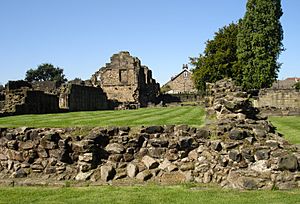Monk Bretton Priory facts for kids
Quick facts for kids Monk Bretton Priory |
|
|---|---|

Remains of Monk Bretton Priory beyond the cloister
|
|
| Type | Priory |
| Location | Abbey Lane, Lundwood |
| OS grid reference | SE376066 |
| Area | South Yorkshire |
| Governing body | English Heritage |
| Owner | Metropolitan Borough of Barnsley |
| Official name: Monk Bretton Priory Cluniac and Benedictine monastery: monastic precinct and two fishponds | |
| Designated | 9 October 1981 |
| Reference no. | 1010057 |
|
Listed Building – Grade I
|
|
| Official name: Monk Bretton Priory remains | |
| Designated | 6 February 1952 |
| Reference no. | 1151178 |
| Lua error in Module:Location_map at line 420: attempt to index field 'wikibase' (a nil value). | |
Monk Bretton Priory is a fascinating old ruin found in the village of Lundwood, near Monk Bretton in South Yorkshire, England. It was once a busy monastery, a place where monks lived and prayed many centuries ago.
A Look Back in Time
This priory, which is a type of monastery, was started in 1154. It was founded by a person named Adam Fitswane. Originally, it was called the Priory of St. Mary Magdalene of Lund. It was built on a piece of land known as "the Lund," a name that comes from an old language called Old Norse.
The monks who lived here belonged to the Cluniac order. This was a special group of monks who followed strict rules. Over time, the priory became known as Monk Bretton Priory, taking its name from the nearby village.
The Notton Family's Gift
In 1350, a man named John de Birthwaite was in charge of Monk Bretton Priory. Around this time, a very important local landowner, Sir William de Notton, and his wife Isabel, gave some land to the priory. Sir William later became a very important judge, the Lord Chief Justice of Ireland.
They wanted the priory to build a special small chapel called a chantry chapel at Woolley Church. In this chapel, prayers would be said for Sir William, Isabel, their children, and also for King Edward III, Queen Philippa of Hainault, and their children. This gift was likely a way for the Notton family to show thanks. It was given after the first terrible outbreak of the Black Death, a widespread and deadly illness that affected many people.
The Priory Closes Down
Monk Bretton Priory closed its doors on November 30, 1538. This happened during a time known as the Dissolution of the Monasteries. This was when King Henry VIII decided to close many monasteries across England.
After it closed, the land first went to the Blithman family. Then, in 1580, it was sold again to George Talbot, 6th Earl of Shrewsbury. He gave the estate to his fourth son, Henry, when Henry married Elizabeth Rayner.
Today, Monk Bretton Priory is a Scheduled Ancient Monument. This means it's a very important historical site that is protected by law. It is now looked after by English Heritage, an organization that cares for many historic places in England.
Over the years, people have done archaeological digs at the site. In the 1920s, excavations focused on the church and cloister areas. More digging happened in the 1950s by the Ministry of Works. Recently, Dr. Hugh Willmott from the University of Sheffield has led new surveys and excavations to learn even more about this historic priory.

